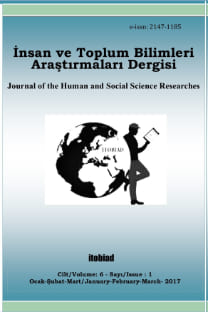Lojistik Regresyonda Aşırı Yayılım Durumunda Williams Yönteminin Etkinliği: BİST 100 Firmaları için Mali Başarısızlığın Belirlenmesi
Aşırı Yayılım, Lojistik Regresyon, Mali Başarısızlık, Faktör Analizi, Williams Yöntemi
Effectıveness of Williams Method in the Case of Overdispersion in Logistic Regression: Application of Financial Distress for BIST 100 Index
Overdispersion, Logistic Regression, Financial Distress, Factor Analysis, Williams Method,
___
- Agresti, A. (1996). Categorical Data Analysis, John Wiley & Sons Inc., New York.
- Akbulut, R. ve Rençber, Ö. F. (2015). Veri Zarflama ve Lojistik Regresyon Analizi ile Çimento İşletmelerinde Finansal Performansa Dayalı Etkinliklerin Değerlendirilmesi, Uluslararası Alanya İşletme Fakültesi Dergisi, 7(3), 123-135.
- Allison, P. D. (1999). Logistic Regression Using the SAS System: Theory and Application, SAS Institude Inc., USA.
- Alpar, R. (2011). Çok Değişkenli İstatistiksel Yöntemler, Detay Yayıncılık, 3. Baskı, Ankara.
- Altman, E. (2005). Corporate Financial Distress and Bankruptcy, Third Edition, John and Wiley & Sons Inc., New York.
- Aydın, N. ve Arı, E. (2016). Hanehalkı Otomobil Talebini Belirleyen Etkenlerin İkili Lojistik Regresyon Yöntemiyle Analizi: Türkiye Örneği, Kastomonu Üniversitesi, İ.İ.B.F. Dergisi, 12 (1), 1-22.
- Cameron, A. C. ve Trivedi, P. K. (1998). Regression Analysis of Count Data, Cambridge University Press, United Kingdom.
- Cox, R. (1983). Some Remarks on Overdispersion, Biometrika, 70 (1), 269-274.
- Czado, C. (2003). Overdispersion in Logistic Regression, Erişim:[http://www-m4.ma.tum.de/courses/GLM/lec5.pdf], Erişim Tarihi: 28.09.2016.
- Field, A. (2009). Discovering Statistics Using SPSS, Sage Publications, 3 th Edition, New York.
- Hilbe, J. M. (2009). Logistic Regression Models, Chapman & Hall/ CRC Press, New York.
- Hosmer, D. W. ve Lemeshow, S. (2000). Applied Logistic Regression, Second Edition, John Wiley & Sons Inc., New York.
- İyit, N. ve Genç A. (2005). Lojistik Regresyon Analizi Yardımıyla Denekte Menopoz Evresine Geçişe İlişkin Bir Sınıflandırma Modelinin Elde Edilmesi, S.Ü. Fen Edebiyat Fak. Fen Dergisi, 25 (1), 19-27.
- Saefuddin, A. Setiabudi N. A. ve Achsani, N. A. (2011). The Effect of Overdispersion on Regression Based Decision with Application to Churn Analysis on Indonesian Mobile Phone Industry, European Journal of Scientific Research, 60(4), pp. 602-610
- SAS (2007). SAS / STAT Software: Changes and Enhancements to SAS / SDTAT Software in Versions 7 and 8, SAS Institute Inc., North Carolina.
- Slaton, T. L. Piegorsch, W. W., ve Durham, S. D. (2000). Estimation and Testing with Overdispersed Proportions Using the Beta- Logistic Regression Model of Heckman and Willis, Biometrics, 56(1), 125-133.
- Suarez, J. ve Susman O. (2004). Financial Distress, Bankruptcy Law and The Business Cycle, Erişim:[http://www.finance.ox.ac.uk/file_links/finecon_papers/2004fe07.pdf], Erişim Tarihi: 19.08.2016.
- Stokes, M. E. Davis, C. S. ve Koch G. G. (2000). Categorical Data Analysis Using The SAS System, John Wiley &Sons Inc., New York.
- Williams, R. (2006). Generalized Ordered Logit / Partial Proportional Odds Models for Ordinal Dependent Variables, The Stata Journal, 6(1), 58-82.
- Wilson J. R. ve Lorenz K. A. (2015). Modeling Binary Correlated Responses Using SAS, SPSS and R,ICSA Book Series İn Statistics 9, Springer Publishing., Switzerland.
- Yeşilova, A. ve Kasap, İ. (2008). Lojistik Regresyonda Meydana Gelen Aşırı Yayılımın İncelenmesi, Yüzüncü Yıl Üniversitesi, Ziraat Fakültesi, Tarım Bilimleri Dergisi,18 (1), 21-25.
- ISSN: 2147-1185
- Yayın Aralığı: 4
- Başlangıç: 2012
- Yayıncı: Mustafa SÜLEYMAN ÖZCAN
Teşvik Kapsamında Elde Edilen Maddi Duran Varlıkların Muhasebe Standartları Kapsamında İncelenmesi
HARUN BÜBER, FAZLI YILDIZ, GÖKSEL KARAŞ
Ekonomik Büyümenin Çevresel Maliyeti: Türkiye ve İran Ölçeğinde Co2 Emisyonlarının Belirleyicileri
Türkiye'nin Canlı Hayvan, Et ve Deniz Ürünleri İhracatındaki Rekabet Gücünün Analizi
4857 Sayılı İş Kanunundaki Esneklik Düzenlemeleri Ve Uygulama Problemleri
Dtö Doha Müzakereleri ve Tarım Politikalarında Yeni Yönelimler
Zahra FOTOUREHCHİ, HACI AHMET ŞAHİNÖZ
Cinsiyete Duyarlı Bütçeleme: Türkiye Örneği
UMUT TEPEKULE, PELİN MASTAR ÖZCAN, GÜL KAYALIDERE
Eğitim ile Bencillik Arasındaki İlişki: Dumlupınar Üniversitesi Örneği
